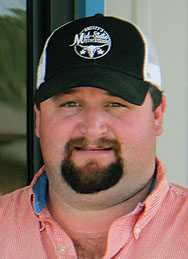
Farmers need to make a profit and balance conventional wisdom, and diverging from that wisdom based on observation and experimentation.
Bill Stuckert is a good example of systematically diverging and then analyzing if the divergence is profitable.
Bill served in the army as a First Lieutenant in the Army Security Agency and met his future wife Janis on a blind date set up by a buddy’s girlfriend. Fifty-eight years later that relationship is still thriving.
The couple originated in Texas and moved to Oklahoma with their son, Bill, and daughter, Hollis Ann, after Bill was offered a more profitable position with Vinson Supply Company.
Even though finances were tight, Bill loved to hunt and fish and searched until he found a 90-acre tract of rough and undeveloped land. Not wanting to see land go to waste, he added four or five cows, as much as the heavily overgrown acreage could support.
Several years later Janis bought Bill his first registered Hereford female from Watson Ranch in Morris, Okla., and, as the saying goes, they were often running.
“At that time I didn’t even know what bloodlines were, but was thrilled with her gift,” Bill said.
Bill credits government programs with helping him get started. He applied for and was approved for 5 acres a year to help with cleanup, root plowing and sprigging in return for fertilizing according to their instructions. He did one section at a time for 7 to 10 years.
Bill’s job was very time demanding, and a neighbor named Claude Simpson worked at night as a welder. The two men became friends and developed a working relationship as well. Claude had a cow or two so Bill bought the feed while Claude did the feeding, which led to Bill’s farms name of S&S Herefords.
“The name had double duty standing for both Simpson and for my son as the second S in Stuckert and Stuckert,” Bill said with a laugh.
During development of his registered herd, Bill also purchased two tracts of land in another two counties, one for first time heifers and one for haying.
Today, the Stuckerts have a total of 270 acres with 45 registered mommas and one registered bull on the premises, although Bill has interest in two other breeding bulls in partnership with Rusty Jamison, a long time ranching family with similar genetics. Their partnership extends beyond sharing the two bulls because Rusty buys all of Bill’s calves at weaning and develops them, with some sold as registered breeding stock, some to commercial breeders wanting to improve their genetics and a few going to the stockyards.
Bill uses some AI performed by the Oklahoma State University veterinarian and stores semen at Reproductive Entrepreneurs near the university.
“AI does not work well for me in terms of expense and pregnancy rate, so most of my mommas are bred by live cover, though I still work on improving my genetics through AI,” Bill said.
Bill’s hayfield is unique. Documentation going back as far as records go indicates that the land is original prairie land. Janis, a master gardener, easily recognized the prairie grasses: Switchgrass, Eastern Gama, Sideoats Grama and both big and little Bluestem. Natural prairie grass is highly-sought after by horse people who want square bales and just ask to be stocked whenever is convenient for Bill, which means Bill can sell as much as he can raise.
Bill then began to question the conventional wisdom that said fertilizing natural prairie grass provided no benefit and that the proper way to use that land is to place cattle on those fields in the winter with only one cutting in June. Bill soil tested and then custom fertilized according to the results. The land, especially the Switchgrass and Eastern Gamma, responded well. He then asked the Extension Service what the difference was between a cow cutting the grass by grazing or him baling again. After researching, they really didn’t have an answer so Bill baled a second cutting in the fall. That hay was tested and found to be almost as high in nutrition as the first cutting. Bill discovered that conventional wisdom and granddaddy weren’t always right. Instead, for Bill, rotational harvesting for the maximum harvest that the land can support works with two cuttings rather than one on his prairie acreage.
This discovery led to another. Prairie grass hay needs to be completely dry when square baled, and occasionally the weather doesn’t cooperate. In that case, Bill and his hay operation partner, Floyd Kessler of Kessler Farms, devised a method of unrolling the round bales in a barn at the proper time and then re-baling into square bales, which are then loaded into a flatbed and ready for delivery. The process is a workable solution an efficient solution for a weather-related problem while maintaining the quality of the hay.
Because his main grazing area has insufficient cover for all the traditional round bales he purchases, Bill also developed a solution to the dampness between round bales and the ground on which they are stored. He simply brought in a load of rock and fenced off the small area from the cows. The rock drains the water away from the hay and all is well.
Pasture receives attention as well. Bill fertilizes and sprays pastures every spring, spot spraying as needed, especially for Pennsylvania Smart Weed. He over seeds every year with annual rye and drags his pastures weekly to take full of advantage of cow manure as fertilizer.
“I raise cattle because I love it. When I was still working, they served as a pressure release from work stress. Now they fill my days with joy and the kind of busyness that is both healthy and satisfying,” Bill said.







